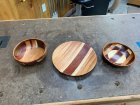Hi all,
I've been making some pieces using laminated blocks of contrasting woods and am running into problems when the ebony dust works into the pores of adjacent lighter woods (usually maple or sycamore) causing a grimy look. You can see that in the attached photo if you look at the hairstick that's roughly in the center of the "bouquet." I've tried compressed air, tack cloths and a wipe with mineral spirits but without success. Any suggestions for preventing this kind of color contamination between adjacent contrasting woods? I'm sanding to 400 grit, finishing with flaxseed oil, so the ebony dust is very, very fine.
I've been making some pieces using laminated blocks of contrasting woods and am running into problems when the ebony dust works into the pores of adjacent lighter woods (usually maple or sycamore) causing a grimy look. You can see that in the attached photo if you look at the hairstick that's roughly in the center of the "bouquet." I've tried compressed air, tack cloths and a wipe with mineral spirits but without success. Any suggestions for preventing this kind of color contamination between adjacent contrasting woods? I'm sanding to 400 grit, finishing with flaxseed oil, so the ebony dust is very, very fine.




